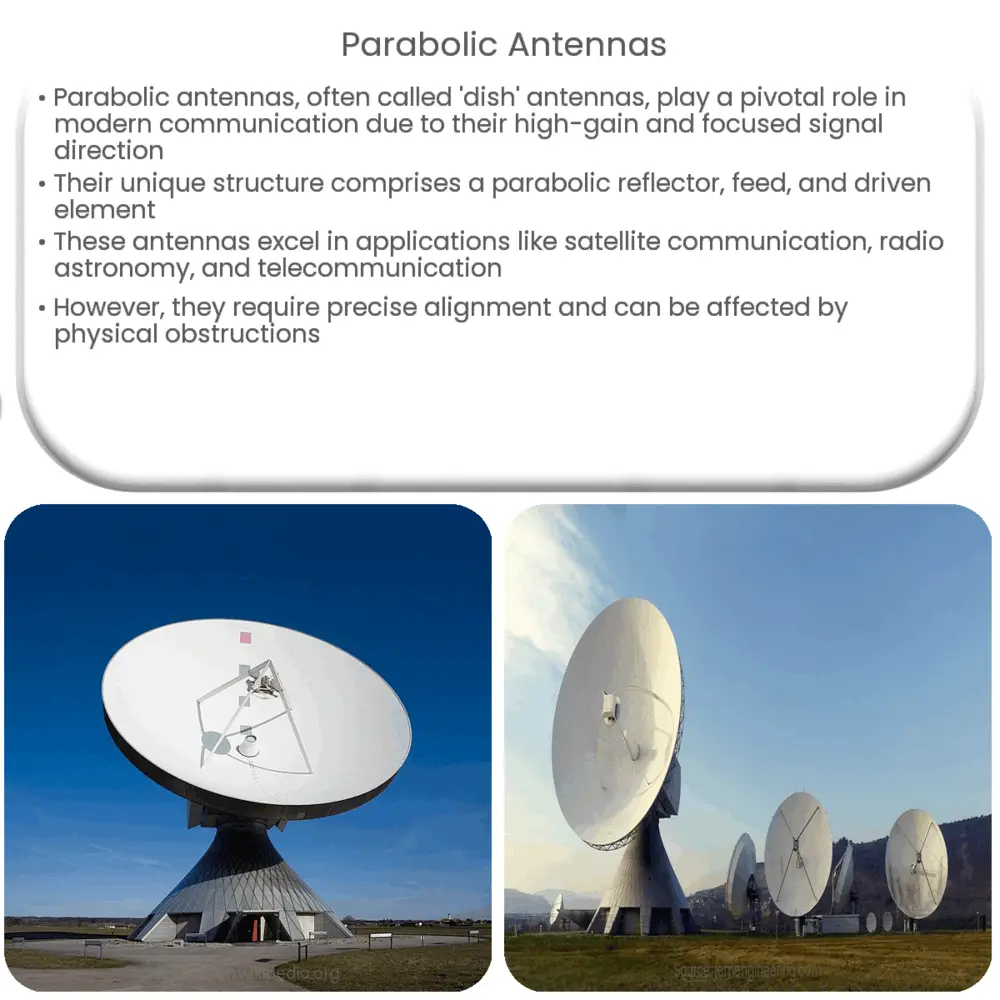Explore the structure, working principle, applications, and limitations of parabolic antennas in modern communication systems.

Introduction to Parabolic Antennas
A parabolic antenna, commonly known as a ‘dish’ antenna, plays a significant role in modern communication systems. It is a high-gain antenna that is designed to receive and transmit signals in a specific direction. Unlike other antenna types, parabolic antennas are unique due to their structure and their ability to focus radio waves in a beam.
Structure and Working Principle
The parabolic antenna is aptly named due to its parabolic shape, typically referred to as a paraboloid. This shape is crucial to its functionality as it enables the antenna to concentrate the signal into a narrow, directed beam. The primary components of a parabolic antenna include the parabolic reflector, the feed, and the driven element.
- Parabolic Reflector: This component, often made of metal, has a parabolic shape. It collects and reflects radio waves from its surface towards the focal point.
- Feed: Positioned at the focal point of the reflector, the feed (or feed antenna) receives the concentrated radio waves and sends them to the receiver, or conversely, it transmits the signal towards the reflector for dispersion.
- Driven Element: This part, located at the focus of the parabola, is the actual antenna in the structure. It can either transmit or receive information.
Directional Characteristics
A distinct characteristic of parabolic antennas is their directional nature, often called ‘high gain’ due to their ability to transmit and receive signals in a specific direction, leading to stronger signals and reduced interference. This trait is advantageous in point-to-point communication and radar systems.
Applications
- Satellite Communication: One of the most prominent applications of parabolic antennas is in satellite communication. Due to their high gain and directional nature, they are particularly well suited to transmit signals to and receive signals from satellites.
- Radio Astronomy: Parabolic antennas are extensively used in radio astronomy to detect and study faint radio waves from space, providing invaluable information about celestial bodies and phenomena.
Telecommunication
Parabolic antennas have proved to be a valuable asset in telecommunication systems, including microwave relay links that carry telephone and television signals over considerable distances. Their high gain and focused transmission characteristics ensure the delivery of high-quality signals across these distances.
Wireless Data Links
For wireless communication, such as Wi-Fi and cellular networks, parabolic antennas are widely used. They are particularly effective in situations where data needs to be transmitted over a long distance between fixed points.
Weather and Radar Systems
In radar systems, the directionality and gain of parabolic antennas are exploited to detect and measure the velocity of objects. They are commonly used in air traffic control, maritime navigation, and weather forecasting. Weather radars, for example, use parabolic antennas to transmit radio waves into the atmosphere, providing crucial data about weather conditions and storm formation.
Limitations
Despite their numerous advantages, parabolic antennas do have some limitations. Due to their high directionality, precise alignment is required when setting up communication links, and their efficiency can be significantly affected by physical obstructions between the transmitting and receiving ends. Additionally, larger antennas, which provide higher gain and better resolution, can be quite bulky and difficult to install.
Conclusion
In conclusion, parabolic antennas, with their unique characteristics and capabilities, serve as a critical component in modern communication and radar systems. Their high gain, directionality, and ability to focus radio waves into a beam enable highly effective transmission and reception of signals across vast distances. Despite some limitations, their benefits significantly outweigh their drawbacks, making them an invaluable tool in various fields such as satellite communication, radio astronomy, telecommunications, and weather forecasting. As technology continues to advance, we can expect further developments and applications of parabolic antennas in the future.

